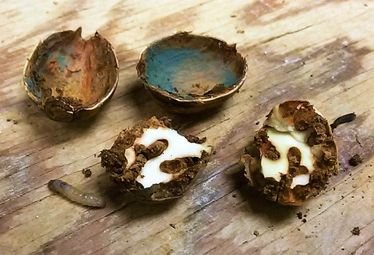- Share this article
- Subscribe to our newsletter
Global seed trade spreads harmful organisms
Non-indigenous insect pests and pathogenic fungi constitute one of the greatest threats to trees and forest ecosystems world-wide. Such harmful organisms can significantly disturb the forest ecology and cause economic losses. In North America, for example, the emerald ash borer (Agrilus planipennis) destroyed the ash trees growing there across extensive areas. This insect has since already infested ash in Western Russia and is thus causing a threat to European ash species. In a similar manner, early in the twentieth century, the pathogenic fungus Cryphonectria parasitica almost exterminated the indigenous American chestnut, which considerably changed the tree composition of forests that had originally been rich in chestnut trees.
During the last few years, Iva Franić, René Eschen and Marc Kenis of CABI as well as researchers from WSL and other institutions have examined the insects and fungi on forest trees for the first time. In the journal Ecological Applications, the scientists point out that the infestation rates among seeds of some tree species are “alarmingly high”. They stress that it has to be checked whether the protective measures applied in the international seed trade are sufficiently effective.
With the aid of X-ray and DNA analysis, the researchers examined insect and fungus infestation among 58 seed lots that are traded and come from eleven coniferous and deciduous tree species. Based on the results, they have formulated recommendations on how the risks caused by harmful organisms transmitted by seed can be reduced. One important measure, they say, would be to improve the detection methods applied by the plant protection inspectors working at country borders.
Iva Franić, lead author of the study ‘Are traded forest seeds a potential source of non-native pests?’, says: “The number of plants imported from China for cultivating in Europe grew six-fold between 2000 and 2018; the import volume from China is now just as large as that from North America.” This increase is creating a considerable challenge for the bodies performing controls along the European Union’s external frontiers. The controls are meant to prevent new harmful organisms being imported. For unfamiliar pathogens can have a considerable impact on the health condition of indigenous trees and even entire forest ecosystems.
High fungus and insect infestation rates
DNA analysis demonstrated that fungi occurred in all seed lots. On non-selective agar, fungi were identified in 96 per cent of the seed lots. Around 30 per cent of the seed lots contained insect larvae. Furthermore, the researchers found out that the incidence of infestation with fungi as well as their diversity were much larger than insect diversity, especially among the seed of deciduous trees.
“Trade in seed of most species is not regulated since seed is assessed as less harmful than other plant material,” says René Eschen of CABI. “At any rate, it is a fact that seeds contain many insects and fungi.”
"Major infestation of commercially traded seed lots is a clear indication of how often potentially harmful organisms are distributed via traded seed,” adds Simone Prospero of WSL. “The fact that organisms are travelling along in the seeds that are already familiar pests and pathogens is a strong sign of how essential it is to take measures to reduce the carry-over risk.”
Since fungi are very difficult to spot in border checks, effective treatment methods are urgently required to shorten their longevity in seed or regulate trade in particularly vulnerable seed varieties or with particularly susceptible places of origin. In order to improve risk assessment, a detailed knowledge of those tree species that can be infested is needed in particular, as is information on how the fungi are transmitted to seedlings and on how infestation with fungi impacts on the seeds and saplings.
(idw/WSL/wi)
Reference:
Iva Franić, Simone Prospero et al.: Are traded forest tree seeds a potential source of nonnative pests?
In Ecological applications, esa, July 2019: doi.org/10.1002/eap.1971





Add a comment
Be the First to Comment